My main goal in visiting Gombe this trip was helping my graduate student, Rebecca Slepkov Nockerts, get started with her project on the stable isotope ecology of chimpanzees and baboons at Gombe.
Over the past couple of decades, stable isotope studies have revolutionized the study of the diets of human ancestors.
Isotopes are variants of chemical elements that differ only in the number of neutrons. For example, carbon has three naturally occurring isotopes, of which Carbon-12 (12C) is the most common. All carbon atoms have 6 protons – that’s what makes them carbon atoms, and not some other element. 12C has 6 protons and 6 neutrons, and is stable – each atom can last for billions of years. Carbon-14 (14C) is a radioactive isotope of carbon. It has 6 protons and 8 neutrons – which makes it unstable. It gradually decays, turning into Nitrogen-14 while spitting off an electron and an electron anti-neutrino. By geological standards, 14C decays relatively quickly, making it useful for dating objects containing carbon that are up to about 60,000 years old.
The third naturally occurring isotope of carbon, 13C, has 6 protons and 7 neutrons, and is stable, though much less common than 12C. For the most part, chemical reactions involve interactions among electrons, and to some extent protons. Neutrons don’t get involved. As a result. 13C behaves chemically almost exactly like 12C. However, in some reactions, the slightly different mass of the heavier isotopes can make a difference. For example, in photosynthesis, molecules containing 13C move more slowly, because they are heavier, and end up in different proportions in the final product.
As it turns out, several different major groups of plants use different mechanisms of photosynthesis, which produce distinct isotopic signatures. Especially important in paleoanthropology are C3 plants (most plants, including most forest species) and C4 plants (certain plants adapted to hot dry climates, including many tropical grasses and sedges).
Unfortunately, all of these different numbered C’s quickly get very confusing! But the main thing to remember is that C3 = forest, C4=grass. Chimpanzees mainly eat C3 forest plants. Even in dry woodlands, chimpanzees eat mainly forest plants: fruit, seeds, flowers and leaves from trees, vines and shrubs growing along rivers and streams. In contrast, baboons eat more C4 plants – especially grass seeds and corms. Similarly, stable isotope studies of fossils have found that early hominins ate mainly C3 plants (and/or animals that ate C3 plants), whereas later hominins at more C4 plants (and/or animals that ate C4 plants).
However, all of these inferences about hominin diet depend on some assumptions about how different tissues reflect diet. Unfortunately, studies comparing hominin isotope signatures to those of living species usually use different tissues. Studies of fossils usually use tooth enamel, which is extremely stable and thus is thought to maintain a good record of the living animal’s isotope signature for millions of years after death. Studies of living primates, however, usually use tissues that are easier to obtain, such as hair and feces, because it is hard to get tooth enamel from living animals (which are generally busy using their teeth). We therefore don’t know nearly enough about how diet translates to isotope signatures across these different tissues in living species. This is what Rebecca plans to find out.
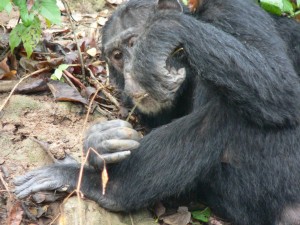
(02 Nov 2006)
The long-term study of chimpanzees and baboons at Gombe brings together the key pieces needed for this study: expertise in identifying and collecting the important food species, long-term records on diet, and skeletons from known individuals. For example, we have a lifetime of data on chimpanzees like Freud, pictured here in November, 2006 eating termites.
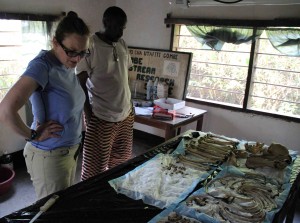
Freud recently died, at nearly 43 years of age (making him one of the longest lived Gombe males). Thanks to concerted efforts over the years by people at Gombe Stream Research Centre, the skeletons of Freud and many other well known individual chimpanzees and baboons have been preserved. Thanks to a lifetime of data on these individuals, we know a lot about what they have been eating. This comprehensive data on individuals will provide an unparalleled amount of detail for matching up diet to isotope signatures of different tissues.
It is particularly interesting to look at chimpanzees and baboons at Gombe because these two quite similar species differ somewhat in their diets in ways that parallel some differences between early and later hominins: baboons eat more grass than chimpanzees, just as later hominins appear to have eaten more grass (and/or grass-eating animals) than earlier hominins.

We are working together with Carson Murray and Rob O’Malley, who are conducting a nutritional study of chimpanzees. Both the nutritional study and the isotope study need foods to be collected, so we will work together to collect foods and share samples.
Rob did his PhD work at Gombe, studying insectivory by chimpanzees. Chimpanzees and baboons both eat a wide range of insects at Gombe.
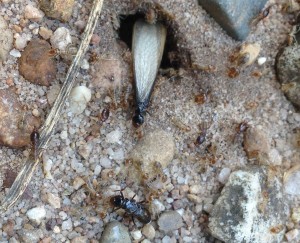
On our first day in the field, we were lucky to catch an emergence of flying termites (“kumbi kumubi” in Swahili). These members of the infraorder Isoptera are one of the most important insect foods, not only for chimpanzees and baboons, but also many birds, monitor lizards, and even people.

We also found a nice column of Dorylus army ants (“siafu” in Swahili).
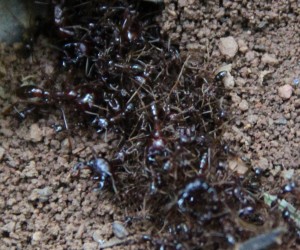
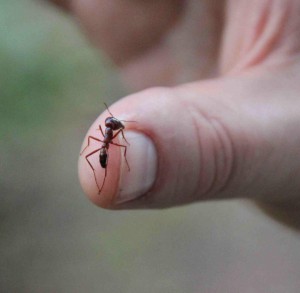
From an isotopic perspective, insects like termites and army ants may be interesting mainly for another isotope, Nitrogen, which provides information about where an animal gets its protein from. The higher the animal’s trophic level (the higher it is in the food chain), the more enriched its tissues are in the heavier Nitrogen isotope, 15N. It will be interesting to see whether chimpanzees and baboons at Gombe differ in their Nitrogen isotope signatures, and whether the isotopic signatures of individual chimpanzees relate to how much meat or insect matter they ate while alive.
At the night meeting, Rob and Rebecca explained their projects to the chimpanzee field staff. Rob talked about nutritional differences that he had found between ants and termites. I noted that “even people like to eat termites, right?” The field assistants responded with many people talking at once. The general consensus: “We like to eat termites, yes, but we like locusts even better!”
And I have to agree. Termite sauce with mushrooms is okay but seems a bit buggy to me, whereas fried locusts quite tasty.
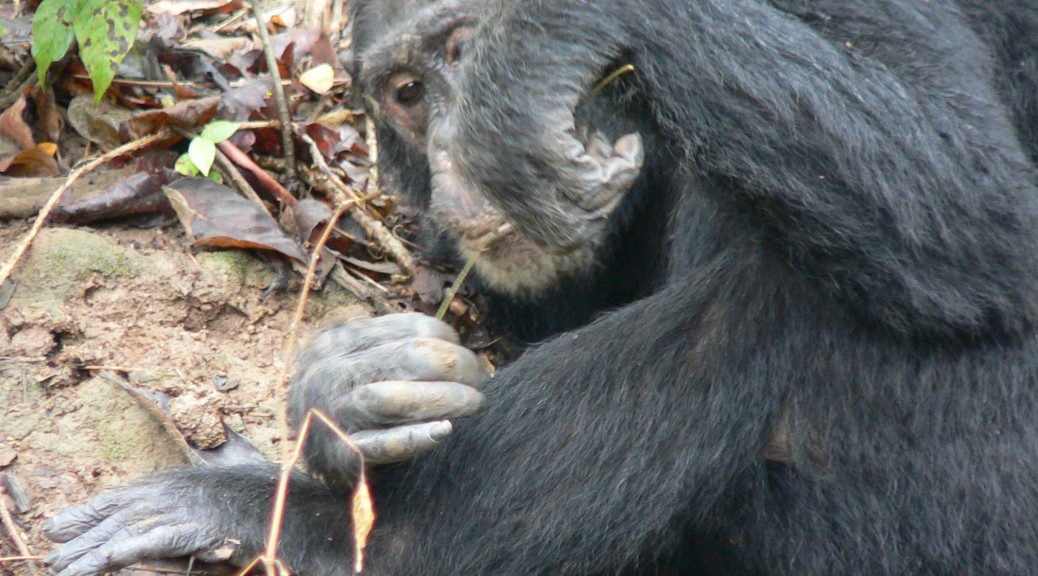
So, how does cooking method affect the 15N concentration?
That’s a good question! The short answer is: I don’t know! But I will post an answer if I find out.